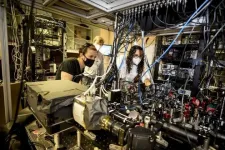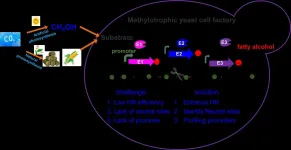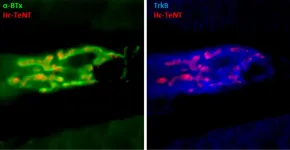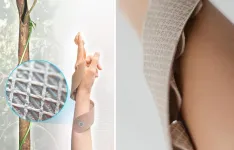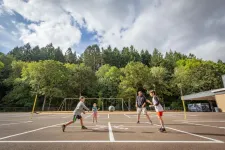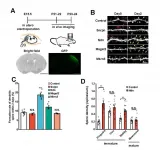(Press-News.org) Strokes, which occur when the blood supply to part of our brain is interrupted or reduced, are the leading cause of death and disability in the adult population. Among the patients who survive, 75% will experience difficulties carrying out daily activities independently and need long-term functional exercises and rehabilitation. But the outcomes using traditional rehabilitation equipment are poor. In addition, the motivation of patients to train is often low.
The Department of Neurology in Tongji Hospital, which is affiliated to Tongji Medical College at the Huazhong University of Science and Technology, is recognised in China for the quality of its scientific research and clinical strength. Similarly, Zhejiang BrainCo, Ltd., incubated by the Harvard Innovation Lab, is a market leader in terms of brain-computer interfaces; considered by many the next generation of artificial intelligence technology.
In the NCyborg Project, the two organisations will draw on their expertise in brain-computer interface technology and brain-inspired intelligent robot technology to establish a stroke rehabilitation process driven by patient initiative. In a paper published in the KeAi journal Brain Hemorrhages, they outline the project's three focus areas:
1.An algorithm for analysing the movement intention of stroke patients based on brain-computer interface technology.
2. A motion control strategy for a rehabilitation robot based on brain-inspired motion perception.
3.The mechanism of stroke rehabilitation using brain-inspired intelligent robots.
They will begin by training the robot to support rehabilitation of the hand - a body part often left with limited movement following a stroke. The team aims to achieve recognition of no less than eight hand movement intentions with an accuracy rate of ?90% and a response time of ?300 ms.
Co-corresponding author, Jonh H. Zhang, explains: "The project's goal is to develop an easy-to-use, reliable and affordable stroke rehabilitation robot that will improve the rehabilitation effect for stroke survivors, speed up the rehabilitation process, and reduce the costs involved."
His co-corresponding author, Bicheng Han, adds: "Our hope is that, within five years, millions of stroke patients will be using this product and see their lives improve."
According to co-corresponding author Zhouping Tang, the 'N' in the NCyborg Project name stands for 'neural', while in fictional stories 'cyborg' is often "an icon that is enhanced mentally and/or physically over and above the 'norm' with technology. In the real word, we believe that NCyborg Project will set up a brand-new stroke rehabilitation pattern which could qualitatively improve the treatment effect for stroke survivors."
INFORMATION:
Contact the corresponding authors: Jonh H. Zhang johnzhang3910@yahoo.com, Bicheng Han bicheng.han@brainco.tech, Zhouping Tang ddjtzp@163.com
The publisher KeAi was established by Elsevier and China Science Publishing & Media Ltd to unfold quality research globally. In 2013, our focus shifted to open access publishing. We now proudly publish more than 100 world-class, open access, English language journals, spanning all scientific disciplines. Many of these are titles we publish in partnership with prestigious societies and academic institutions, such as the National Natural Science Foundation of China (NSFC).
Contrary to conventional thought, songbirds can taste sugar--even though songbirds are the descendants of meat-eating dinosaurs and are missing a key protein that allows humans and many other animals to taste sweetness. An international team investigated how many bird species can taste sweet and how far back that ability evolved. Their work was published today in the journal Science.
The researchers offered two species of songbirds a choice between sugar water and plain water--nectar-taking honeyeaters, as well as canaries, a grain-eating bird not known for consuming sweet foods. They also examined taste receptor responses sampled from a variety of other species. Regardless of whether their main ...
A team of physicists from the Harvard-MIT Center for Ultracold Atoms and other universities has developed a special type of quantum computer known as a programmable quantum simulator capable of operating with 256 quantum bits, or "qubits."
The system marks a major step toward building large-scale quantum machines that could be used to shed light on a host of complex quantum processes and eventually help bring about real-world breakthroughs in material science, communication technologies, finance, and many other fields, overcoming research hurdles that are beyond the capabilities of even the fastest supercomputers today. Qubits are the fundamental building blocks on which quantum computers ...
How does unicellular life transition to multicellular life? The research team of Professor Lutz Becks at the Limnological Institute of the University of Konstanz has taken a major step forward in explaining this very complex process. They were able to demonstrate - in collaboration with a colleague from the Alfred Wegner Institute (AWI) - that the unicellular green algae Chlamydomonas reinhardtii, over only 500 generations, develops mutations that provide the first step towards multicellular life. This experimentally confirmed a theory on the origin of multicellular life, which says that the evolution of cell groups and the subsequent steps towards multicellularity can only take place when cell groups are both better at reproduction and more likely to survive than single cells. ...
Although the giant panda is in practice a herbivore, its masticatory system functions differently from the other herbivores. Through the processes of natural selection, the giant panda's dietary preference has strongly impacted the evolution of its teeth and jaws. Researchers from the Institute of Dentistry at the University of Turku and the Biodiversity unit of the University of Turku together with researchers from the China Conservation and Research Center for Giant Panda (CCRCGP) have been the first in the world to solve the mystery of how the giant panda's special stomatognathic system functions.
The bamboo diet of the giant panda (Ailuropoda melanoleuca) has long been a ...
Pichia pastoris (syn. Komagataella phaffii), a model methylotrophic yeast, can easily achieve high density fermentation, and thus is considered as a promising chassis cell for efficient methanol biotransformation. However, inefficient gene editing and lack of synthetic biology tools hinder its metabolic engineering toward industrial application.
Recently, a research group led by Prof. ZHOU Yongjin from the Dalian Institute of Chemical Physics (DICP) of the Chinese Academy of Sciences established an efficient genetic engineering platform in Pichia pastoris.
The study was published in Nucleic Acids Research on July 1.
The researchers developed ...
Depression has been treated traditionally with inhibitors of serotonin reuptake in the central nervous system. These drugs do not come without side effects, such as lack of immediate therapeutic action, the need for daily doses and the danger of becoming addicted to some of these drugs. That is why scientists continue to work on new therapies to treat depression.
In 2019, an international group of researchers co-led by Dr Yousef Tizabe from the Howard University College of Medicine in Washington, D.C., and Professor José Aguilera from the Department of Biochemistry and Molecular Biology and the Institut de Neurociències ...
To splice or not to splice...
In an article published in the journal RNA, Karan Bedi, a bioinformatician in Mats Ljungman's lab, Department of Radiation Oncology at the University of Michigan Medical School, investigated the efficiency of splicing across different human cell types. The results were surprising in that the splicing process appears to be quite inefficient, leaving most intronic sequences untouched as the transcripts are being synthesized. The study also reports variable patterns between the different introns within a gene and across cell lines, and it further highlights ...
Researchers at the University of Freiburg and the University of Stuttgart have developed a new process for producing movable, self-adjusting materials systems with standard 3D-printers. These systems can undergo complex shape changes, contracting and expanding under the influence of moisture in a pre-programmed manner. The scientists modeled their development based on the movement mechanisms of the climbing plant known as the air potato (Dioscorea bulbifera). With their new method, the team has produced its first prototype: a forearm brace that adapts to the wearer and which can be further developed for medical applications. ...
Recess quality, not just the amount of time spent away from the classroom, plays a major role in whether children experience the full physical, mental and social-emotional benefits of recess, a new study from Oregon State University found.
"Not all recess is created equal," said William Massey, study author and an assistant professor in OSU's College of Public Health and Human Sciences. With schools returning to full-time in-person classes this fall, he said, "Now is a good time to rethink, 'How do we create schools that are more child-friendly?' I think ensuring quality access to play time and space during the school day is a way we can do that." ...
A research group including Kobe University's Professor TAKUMI Toru (also a Senior Visiting Scientist at RIKEN Center for Biosystems Dynamics Research) and Assistant Professor TAMADA Kota, both of the Physiology Division in the Graduate School of Medicine, has revealed a causal gene (Necdin, NDN) in autism model mice that have the chromosomal abnormality (*1) called copy number variation (*2).
The researchers hope to illuminate the NDN gene's molecular mechanism in order to contribute towards the creation of new treatment strategies for developmental disorders including autism.
These research results were published in Nature Communications on July 1, 2021.
Main Points
The research ...

